Who doesn't love D. polytricha, and the fussier D. mollissima and D. longisiliqua? I actually have grown these pretty well for a few years in this or that perfect little microclimate. But Draba rigida pays rent. This makes as dense and hard a cushion as any Dionysia, and seems to grow with impugnity in almost any microclimate in a classic rock garden: I have it on slopes facing every direction, in crevices, in hot spots and in quite deep shade. No matter where it is placed it seems to settle down, and then year after year, decade after decade, just gets bigger and bigger and better, blooming for much of the spring and setting copious seed! It doesn't get much better than that!
I think we can thank the Czechs once again (probably Josef Jurasek) for reintroducing fresh germplasm of this fifteen or so years ago which gave the plant a new lease on life. A big reason why we need wild seed collection!
Comments
Re: My favorite all round Draba
Seems to be a trend with me, showing lots of plants that I've killed :o
One of my very favorite Draba species is D. sierrae, a California endemic, found in alpine fell-fields between 11000 and 12500 feet. It lasted a good number of years in one of my original troughs that I made 38 years ago and transported to my currently location when my parents sold their house about 9 years ago. I found the tiny cushions most attractive after flowering. I would sprinke the seed around and had lots of seedlings coming up. Three years ago I had the house re-roofed, and no matter how adamant I was about being careful not to harm foundation plants and such, they broke both of my troughs and trampled small shrubs and perennials to near death, for which they would only negotiate a $75 discount... wooHOO >:(
So, the trough is still there, but the walls crumbled away and the plants suffered; the draba was a casualty.
I like finding herbarium specimen views of plants where one gets to see the whole structure of a plant.
http://calphotos.berkeley.edu/cgi/img_query?query_src=&enlarge=0000+0000...
http://calphotos.berkeley.edu/cgi/img_query?query_src=&enlarge=3333+3333...
Re: My favorite all round Draba
Alas I can only grow the fuzzies in our alpine house at work and even there, our humidity in winter is apt to kill them. Only D. aizoides is reliable outside for the long term.
Re: My favorite all round Draba
The fuzzies are fine for us outdoors (I may have 30 Draba polytricha in various parts of my garden)...that's called God's compensation for us god forsaken steppe nomads, since we struggle to grow ericads and even little salix like you dank, coastal types!
I just blogged about Draba hispanica, which has been in cheery bloom all week in my garden: check it out:
http://www.botanicgardensblog.com/2010/03/04/anything-but-drab-2/#more-3292
Re: My favorite all round Draba
I just blogged about Draba hispanica, which has been in cheery bloom all week in my garden: check it out:
http://www.botanicgardensblog.com/2010/03/04/anything-but-drab-2/#more-3292
I like the Arizona-Alaska analogy and the need to use a compass in the garden... true in many ways :)
Re: My favorite all round Draba
I have not tried Draba in my garden yet lacking appropriate place. I know some wild species from the highest Norwegian mountains and I have often met them abroad. Here are one I saw on Mt Ararat in eastern Turkey.
It could be D. araratica.
Re: My favorite all round Draba
What a great picture! Mt Ararat, eh? I would dearly love to go there (I suspect permits could be a problem so near Armenia?)...
It would be fun to see this up close: I have a hunch it is closely allied to the Draba bruniifolia/olympica group. Has that look about it, and they are widely distributed in Turkey. Looks to be very compact...
Re: My favorite all round Draba
What a great picture! Mt Ararat, eh? I would dearly love to go there (I suspect permits could be a problem so near Armenia?)...
It would be fun to see this up close: I have a hunch it is closely allied to the Draba bruniifolia/olympica group. Has that look about it, and they are widely distributed in Turkey. Looks to be very compact...
We had no problems getting permits (our guide saw to it - we only paid!!) The view from the summit was stunning. We could see Iran (our guide said it was no problem getting into Iran either), Georgia, Armenia (and the capital Jerevan) and a part of Azerbaijan (Nakhitsjevan).
However, I think the flora of other mountains were more exuberant.
Pictures of Mt Ararat, Draba araratica (?) (sorry, could not get it better) and an unknown species from Mt Suphan.
Re: My favorite all round Draba
The view from the summit was stunning. We could see Iran (our guide said it was no problem getting into Iran either), Georgia, Armenia (and the capital Jerevan) and a part of Azerbaijan (Nakhitsjevan). However, I think the flora of other mountains were more exuberant.
Pictures of Mt Ararat, Draba araratica (?) (sorry, could not get it better) and an unknown species from Mt Suphan.
Nice drabas, I like the second one popping out of solid rock... what a setting. Dramatic view of Mt. Ararat, now I can visualize the home of a plant I purchased at the NARGS Eastern Winter Study Weekend, Onosma araraticum :o

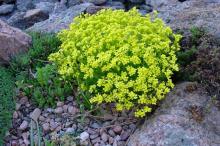
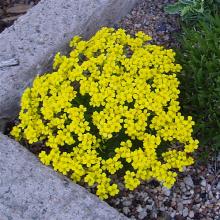
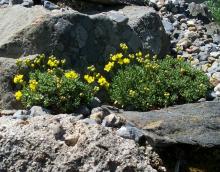
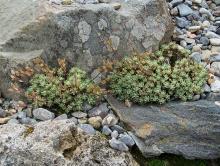
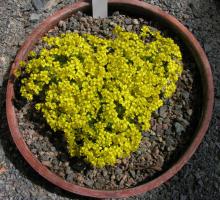
I have to agree! It is a strong, long-lived plant even in this harsh climate, where it will go from this drab resting winter form, to an amazing display through May and June!